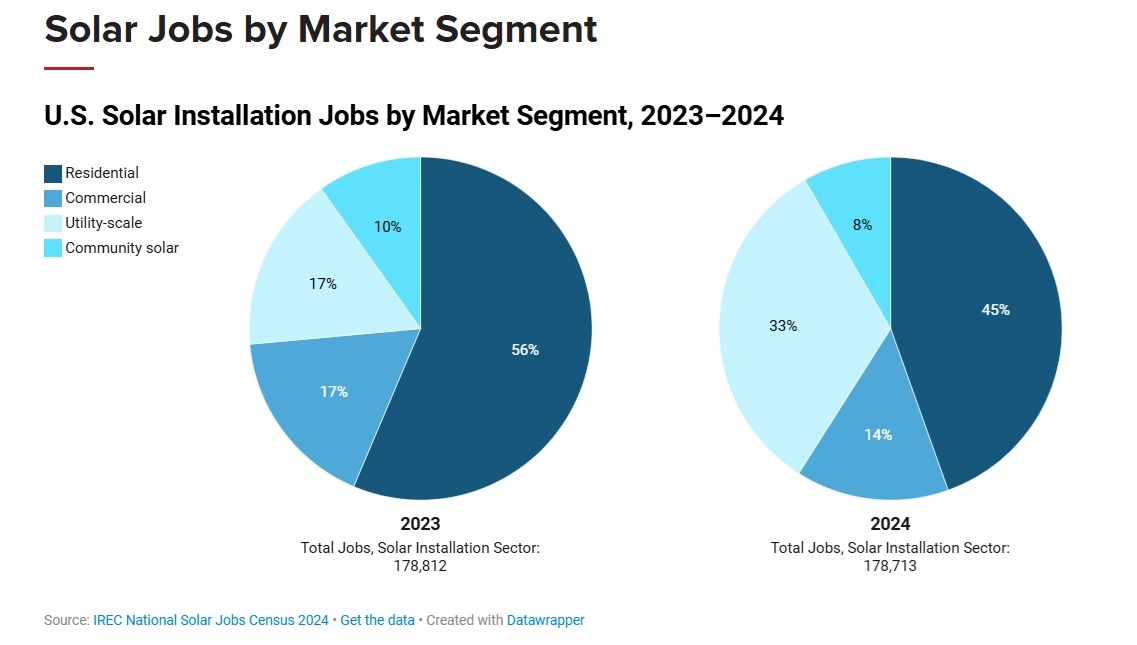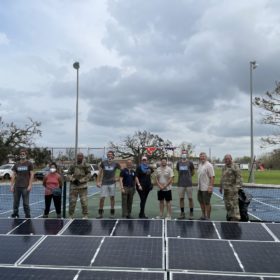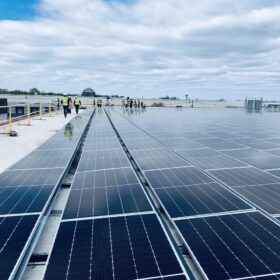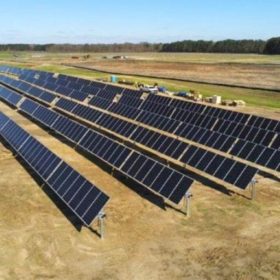The Interstate Renewable Energy Council’s (IREC) 15th annual National Solar Jobs Census finds that solar and battery energy storage employed over 464,053 workers in 2024, holding steady with its 2023 figure. While federal policy changes in the OBBBA presented challenges to the industry, solar has proven to be one of the most cost-competitive sources of electricity, and is here to stay, the study finds.
IREC reports that the National Solar Jobs Census is based on a survey administered to tens of thousands of energy firms in 2024 and therefore does not reflect impacts of the OBBBA on the solar industry. Which was reported to have led to cancellation of over $6.7 billion in projects in June 2025 alone.
States with notable increases in job numbers occurred in what the report calls “Republican-leaning ‘red’ states: Ohio (5%), Georgia (4.5%), Utah (3.5%), and Texas (3%). See the state-specific solar employment numbers in IREC’s interactive map.
The expansion of battery energy storage was found to contribute to “significant job growth,” increasing 4% in 2024 and 17% in the five-year period between 2019 and 2024.
The census found that there are approximately 280,119 employed in the solar industry who focus primarily on solar, up slightly from the 2023 figure of 279,447. If you add in those who serve other industries as well, the number rises to over 370,000, IREC reports. Additionally it found that over 93,000 people focus primarily on battery energy storage, bringing the total to over 464,000 in solar and storage in 2024.
IREC concluded that he solar industry accounts for more jobs than any clean energy industry other than energy efficiency and employs more than three times more than the coal industry.

The Solar Jobs Census finds that the majority of people employed in solar are in the installation sector (64%). This sector includes construction workers and electricians, along with many other supporting roles, such sales, marketing, software, management, and
finance. With incentives in the Inflation Reduction Act for domestic manufacturing, the U.S. has seen strong growth in that sector; however, the manufacturing job number of 32, 491 does not reflect the strong growth because few new facilities were fully online by the end of the year.
The IREC report points to an estimate by the Solar Energy Industries Association (SEIA) that anticipates that if all the announced solar and storage facilities came online, manufacturing jobs will rise to 75,000 by the end of the decade. Analysts expect that domestic manufacturing will stall in future years with some facilities closing or being sold, due to changes in federal legislation under the Trump administration, the report notes.
Looking ahead
Growth in solar deployment skyrocketed In 2024, with the U.S. installing 50 GW of new solar capacity, which IREC notes is more than double the capacity installed two years before and nearly four times the amount in 2019. Jobs, however, have not increased by the same factor due to increased efficiency. For example, the report states that between 2010 and 2019, solar jobs increased by 167% with more than 150,000 jobs added. Then, in the five-year period between 2019 and 2024, solar jobs grew by 12% while installed solar capacity increased by 286%. The report attributes increased efficiency to larger installations as well as new technologies including digital scheduling tools, remote monitoring, modular components, and the recent launch of robots and AI.
In 2025, the Trump Administration and new Congress scaled back support for solar and other renewables in favor of fossil fuels, which the report expects to further discourage solar deployment. All is not lost; however, as IREC notes that the many benefits of solar and demand for excessive energy generation will keep solar competitive with other energy sources. The rush to install projects before tax credits expire will buoy the industry in the near term, and the report points to analyst estimates that solar deployment could be reduced by over 20% compared to projected growth before the legislation was enacted.
The report concludes that solar jobs numbers will remain steady in 2025 and jobs “will likely keep increasing in emerging industries like battery storage as well as in energy efficiency fields.”
This content is protected by copyright and may not be reused. If you want to cooperate with us and would like to reuse some of our content, please contact: editors@pv-magazine.com.









By submitting this form you agree to pv magazine using your data for the purposes of publishing your comment.
Your personal data will only be disclosed or otherwise transmitted to third parties for the purposes of spam filtering or if this is necessary for technical maintenance of the website. Any other transfer to third parties will not take place unless this is justified on the basis of applicable data protection regulations or if pv magazine is legally obliged to do so.
You may revoke this consent at any time with effect for the future, in which case your personal data will be deleted immediately. Otherwise, your data will be deleted if pv magazine has processed your request or the purpose of data storage is fulfilled.
Further information on data privacy can be found in our Data Protection Policy.